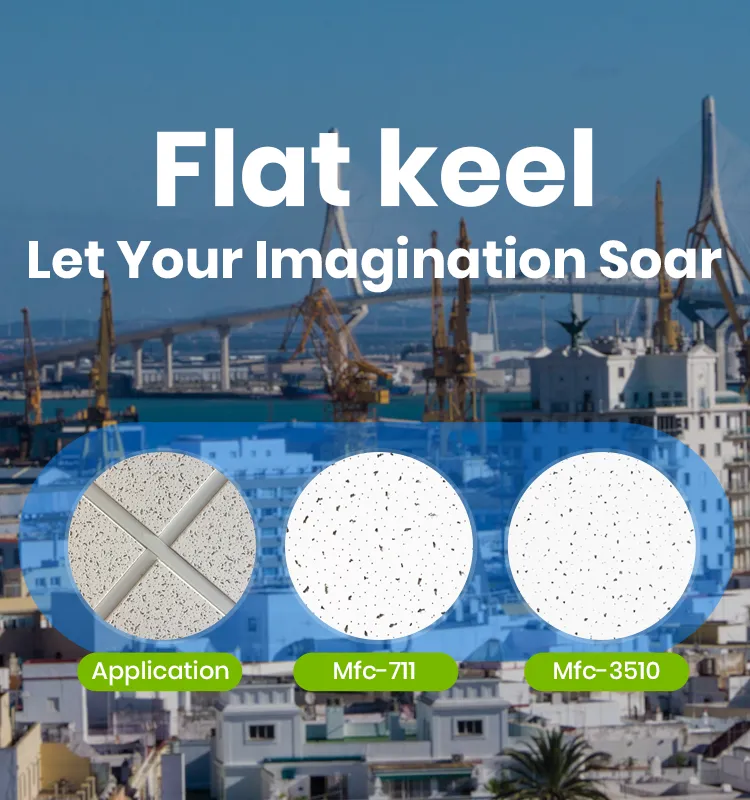Nov . 11, 2024 07:15 Back to list
grid ceiling tiles material
The Rise of Grid Ceiling Tiles An Essential Guide to Materials
In contemporary interior design, ceiling aesthetics have gained significant attention, and grid ceiling tiles have emerged as a popular choice. These tiles not only influence the overall ambiance of a space but also serve functional purposes such as sound absorption, thermal insulation, and low maintenance. Understanding the various materials used in grid ceiling tiles can help in making informed design choices that suit a variety of environments, from offices to homes.
What Are Grid Ceiling Tiles?
Grid ceiling tiles, also known as drop ceiling tiles or suspended ceiling tiles, are placed in a grid framework hanging from the structural ceiling. This modular design allows for easy installation and access to plumbing, electrical, and HVAC systems above the ceiling. The tiles can be made from different materials, each providing unique attributes that cater to various needs.
Common Materials Used in Grid Ceiling Tiles
1. Mineral Fiber The most common material for grid ceiling tiles is mineral fiber. These tiles are composed of natural minerals and are known for their excellent sound-dampening qualities. Mineral fiber tiles are lightweight, easy to install, and often come with acoustic ratings that enhance the sound quality of a room. They can be treated to resist moisture, making them ideal for areas such as bathrooms and kitchens.
2. Fiberglass Fiberglass tiles are another popular option. They are known for their durability and superior thermal insulation properties. These tiles resist moisture, mold, and mildew, making them suitable for humid environments. Fiberglass grid ceiling tiles usually feature a smooth surface and can be painted, providing flexibility in design aesthetics.
3. PVC (Polyvinyl Chloride) PVC tiles are valued for their high resistance to moisture and ease of maintenance. They do not absorb water and can be cleaned easily with a damp cloth. PVC tiles are available in various designs and colors, allowing for expansive flexibility in style. They can be ideal in commercial settings where spills or contamination from cleaners might occur regularly.
4. Metal For a more industrial or modern aesthetic, metal grid ceiling tiles are an excellent choice. Made from steel or aluminum, these tiles can add a sleek, polished look to a space. They are durable, fire-resistant, and can be designed with perforations for sound control. Metal tiles work well in high-traffic areas or spaces requiring high hygiene standards, such as hospitals and restaurants.
grid ceiling tiles material

5. Wood Wood ceiling tiles bring warmth and elegance to interiors. Typically crafted from natural wood or engineered wood, these tiles are available in various finishes and textures. While they provide aesthetic appeal, wood tiles require more maintenance to protect against moisture and potential warping. They are best suited for dry areas and can create a cozy atmosphere.
6. Acoustic Tiles Acoustic ceiling tiles are specifically designed to address sound absorption. Often made from combinations of mineral fiber and fiberglass, these tiles are ideal for environments where noise reduction is crucial, such as offices, schools, and theaters. Their effectiveness in controlling sound echoes makes them invaluable in public and communal spaces.
Choosing the Right Material
When selecting grid ceiling tiles, it is essential to consider several factors
- Functionality Determine the primary function—acoustic performance, moisture resistance, or aesthetic appeal—that the ceiling tiles need to fulfill. - Environment Assess the specific conditions of the space. For example, high-humidity areas will benefit more from fiberglass or PVC tiles.
- Design and Aesthetics Consider the overall design theme of the space. Choose a material that will complement the existing décor and intended mood.
- Budget Different materials come with varying price points. It’s important to find a balance between quality and affordability.
Conclusion
Grid ceiling tiles are a versatile and integral component of modern interior design, offering both practical benefits and aesthetic value. By understanding the various materials available—mineral fiber, fiberglass, PVC, metal, wood, and acoustic options—designers and homeowners can make choices that enhance both the look and functionality of their spaces. Each material has unique characteristics, ensuring that there is a suitable option for every environment and stylistic preference. Ultimately, the right grid ceiling tile can transform a plain ceiling into a stunning visual feature that contributes positively to the overall atmosphere of any room.
-
Quality Ceiling Trap Doors & Access Panels | Easy & Secure AccessNewsAug.30,2025
-
Durable Ceiling T Grid Systems | Easy InstallationNewsAug.29,2025
-
PVC Gypsum Ceiling: Durable, Laminated Tiles for Modern SpacesNewsAug.28,2025
-
Pvc Gypsum Ceiling Is DurableNewsAug.21,2025
-
Mineral Fiber Board Is DurableNewsAug.21,2025
-
Ceiling Tile Clip Reusable DesignNewsAug.21,2025







